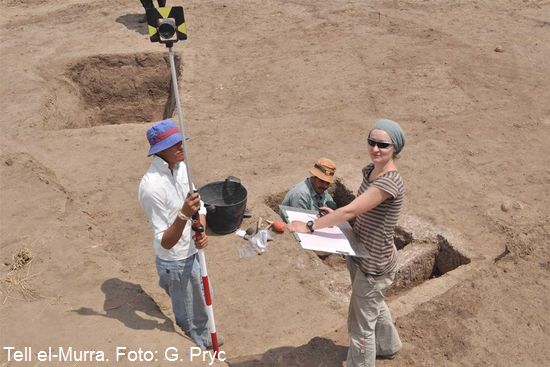Tell-el-Murra excavations reveal settlement dating back to 3500 BC

The Jagiellonian University archeologists have been carrying out excavations in Tell-el-Murra, Egypt, since 2008. The settlement discovered this year is located in the north-eastern part of the Nile Delta and its beginnings go back to 3500 BC.
Tell el Murra is a small hill with the remains of an ancient settlement, founded approximately 5500 years ago. As a result of 1300-year-long settlement, sun-dried brick constructions formed a hill, towering over farm fields.
"Thanks to the works carried out this year we managed to determine that the examined part of the settlement was inhabited in the Old Kingdom period (3rd – 6th Dynasty), i.e. when Memphis pyramids were under construction", says Dr Mariusz Jucha, the expedition leader.
The excavations revealed the remains of residential and utility buildings. Particularly interesting, according to the archeologists, were numerous ring-shaped structures. They served as grain silos. The largest one, made of sun-dried bricks, measured approximately 3.5 m in diameter. The researchers also unveiled buildings divided into oblong sections.
"We still do not know what made Tell-el-Murra inhabitants leave this place by the end of the Old Kingdom period. Why the settlement, the beginnings of which go back to 3500 BC, was abandoned after 1300 years of existence?," wonders Dr Jucha.
The buildings erected in the declining years of Tell-el-Murra settlement are much less impressive than the older constructions. The settlement was less extensive too.
"It seems that the first signs of crisis, the reasons for which are still unknown, appeared much earlier, i.e. in the Early Dynastic Period, 1st – 2nd Dynasty", notes Dr Jucha.
Probably at that time the north-western part of the settlement was abandoned, and the site was used for burials. Those inhabitants who decided to stay moved their households to northern and eastern part of the settlement.
The archaeologists will try to unravel this secret in further phases of the project. They also intend to examine the remains of the settlement even older than the Old Kingdom period, located beneath the constructions examined this year.
The researchers from the Institute of Archaeology, Jagiellonian University, also carried out excavations at the cemetery situated next to the settlement. They discovered burial sites dating back to the Early Dynastic period. Among the finds was an atypical burial site with ceramic coffin akin to that discovered in Tell-el-Murra in the previous years.
"Ceramic coffins were rarely used in the Nile Delta. The fact that we find them here may suggest the differences between neighbouring settlements. The question that arises is what was the reason for these differences", concludes Dr Jucha.
Published by: Łukasz Wspaniały
Uniwersytet Jagielloński

